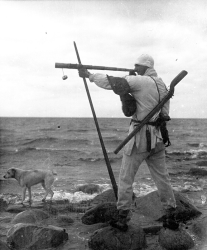Seal-hunting on Ruhnu 



Seal hunting or sealing was the most important and profitable yet also the harshest and most dangerous job for men on Ruhnu; still in the 1930s it was one of the main sources of livelihood for the islanders. Seal hunting grounds extended to the east part of the Gulf of Finland - to the areas surrounding Kõrgessaare, Tütarsaare and Lavansaari. After the First World War seals were hunted closer by in less profitable areas in the Gulf of Riga, on the coasts of Saaremaa and Muhu Islands. The hunting season was in early spring after the seals had given birth and when the baby seals did not go into the water and the mothers would not leave their young. For hunting on ice, guns and harpoons were used, baby seals were killed with clubs (baby seals have the best fur). Hunters spent several weeks in a row on ice, equipment and game were transported on sledges or on special boats with runners (sealing boats). In open water, seal nets, fykes and hooks were used. Seals were hunted for their fur, fat and meat. Game was distributed equally among all members of the hunting party. The shooter kept the fur, fat was sold and meat was either eaten or given to pigs. Seal hunting continued during the Soviet period. National quotas were set for seal fat, which was the raw material used in dubbin manufacturing. In the 1950s and in the beginning of 1960s there were a lot seals and the they caused a lot damage to the fishing industry by breaking traps, on account of which so called bounty was paid for killing each seal. During that time, the main hunting equipment were nets. Since the 1980s the number of seals in the Baltic Sea has been decreasing and they are no longer hunted industrially.
Created in 2014






